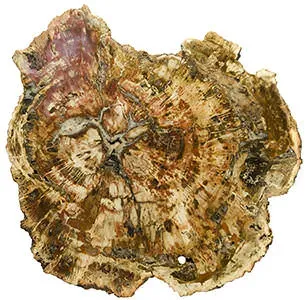 Chalcedony is brittle and has a waxy, dull luster. It may be semitransparent or
translucent and is vitreous when polished. It can assume a wide range of colors,
but those most commonly seen are white to gray, grayish-blue or a shade of
brown ranging from pale to nearly black. When chalcedony comes in different
colors, the colors are due to embedded minerals. Chalcedony is not its own
mineral species- it is a form of
Chalcedony is brittle and has a waxy, dull luster. It may be semitransparent or
translucent and is vitreous when polished. It can assume a wide range of colors,
but those most commonly seen are white to gray, grayish-blue or a shade of
brown ranging from pale to nearly black. When chalcedony comes in different
colors, the colors are due to embedded minerals. Chalcedony is not its own
mineral species- it is a form of ![]() quartz in microcrystalline form. Other forms- with
multicolored bands for example Agate, have their own name. Chalcedony rates a
6.5 - 7 on Moh's hardness scale.
quartz in microcrystalline form. Other forms- with
multicolored bands for example Agate, have their own name. Chalcedony rates a
6.5 - 7 on Moh's hardness scale.
 Chalcedony can be found as vein fillings or crusts in volcanic rocks, as the main
constituent in silica-rich marine sedimentary rocks, as layers in limestone and
marls, as cement in sandstones, and as a fossilizing material. A well-known
example of Chalcedony forming pseudomorphs after organic material is in the
Petrified Forest National Monument in Arizona- there; an entire forest
transformed into petrified wood. Remains of this forest are now found in large
silicified logs in the area. Another example is in coral. In Tampa Bay, Florida,
coral has been chemically replaced by Chalcedony and its original form is
preserved. Tiger's Eye is yet another example- the golden streaks within the
stone are caused by Crocidolite, a fibrous mineral that was chemically replaced
into Chalcedony through pseudomorphism.
Chalcedony can be found as vein fillings or crusts in volcanic rocks, as the main
constituent in silica-rich marine sedimentary rocks, as layers in limestone and
marls, as cement in sandstones, and as a fossilizing material. A well-known
example of Chalcedony forming pseudomorphs after organic material is in the
Petrified Forest National Monument in Arizona- there; an entire forest
transformed into petrified wood. Remains of this forest are now found in large
silicified logs in the area. Another example is in coral. In Tampa Bay, Florida,
coral has been chemically replaced by Chalcedony and its original form is
preserved. Tiger's Eye is yet another example- the golden streaks within the
stone are caused by Crocidolite, a fibrous mineral that was chemically replaced
into Chalcedony through pseudomorphism.
 Chalcedony has many healing properties. It is a nurturing stone that promotes
overall generosity. It is said to aid with emotional balance, stamina, vitality,
endurance, energy, kindness, and friendliness. It alleviates hostility, self-doubt,
negative thoughts and emotions, and nightmares. Chalcedony is said to help
symptoms of dementia and senility. The stone has also been said to have the
power to heal the eyes, gallbladder, bones, spleen, and blood and circulatory
systems.
Chalcedony has many healing properties. It is a nurturing stone that promotes
overall generosity. It is said to aid with emotional balance, stamina, vitality,
endurance, energy, kindness, and friendliness. It alleviates hostility, self-doubt,
negative thoughts and emotions, and nightmares. Chalcedony is said to help
symptoms of dementia and senility. The stone has also been said to have the
power to heal the eyes, gallbladder, bones, spleen, and blood and circulatory
systems.